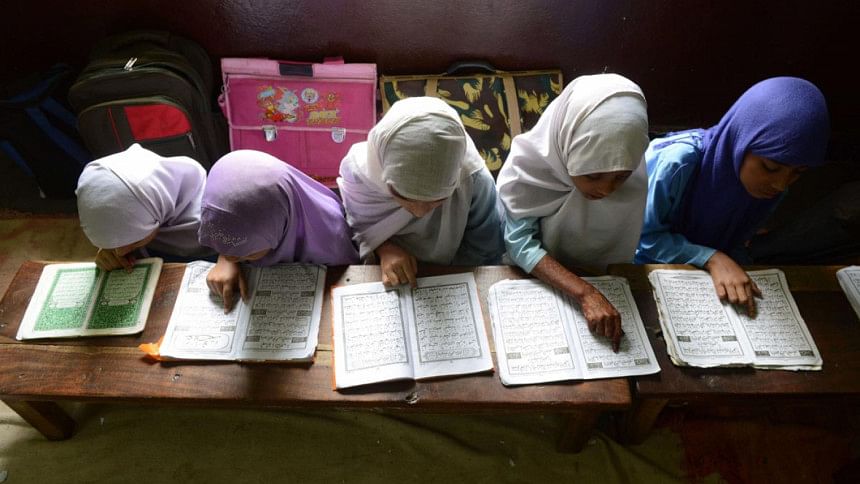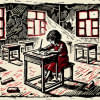Madrassahs: The invisible link in achieving equity

Since the World Conference on Women in Mexico in 1975, Bangladesh has been at the forefront among the least-developed countries (LDCs) in addressing gender disparities. The country's achievements in education and gender parity in education, has also been remarkable. However, despite its success in achieving gender parity in many areas, some sections of the population have been left behind. One such section is female students in madrassah schools.
Arguably, much of the frequently cited increase in enrolment rate and gender parity in education can be accounted for by a rise and recent reform in the madrassah sector. A study by Dr. Niaz Asadullah, Professor of Development Economics in the Faculty of Economics at Malaya University, found that nearly half of the student population in these madrassahs today is female. Musammat Badrunnesha, Echidna Global Scholar and Christina Kwauk, Postdoctoral Fellow — Global Economy and Development, Centre for Universal Education, reported in a study that madrassahs provide education to over 1.5 million girls in Bangladesh. Despite accounting for a large percentage of the student population, female students graduating from this medium of education are seen to frequently disappear from the workforce. In fact, whatever research exists indicate that the majority of girls enrolled in the system will not transition to university or the workforce.
One may be curious as to why this sector has fallen behind in comparison to the rest of the nation. There are several reasons, some of which are historical. During the language movement in 1952, madrassahs were placed in an awkward position because of a strong emphasis on Urdu in the curriculum before 1971. After the country's liberation, some madrassahs continued their curriculum in Urdu and some did not. However, the sector has often been seen as a ground for breeding anti-nationalist and anti-state sentiments amongst students. The international community has also regarded madrassahs as the breeding ground for terrorism, based on the fundamentalist ideologies that they are assumed to promote by virtue of their religious orientation.
On the other hand, madrassahs themselves have also resisted external interventions from NGOs. When NGOs first started operating in Bangladesh, they were often allegedly formed as part of Christian missionary organisations and undertook charitable activities in underdeveloped areas in order to convert people to Christianity. So, as a result of being perceived as having evangelical agendas, NGOs were seen by madrassahs as existential threats.
Despite madrassah's complicated relationship with the state and the international community, madrassahs have been far from irrelevant. Of the two kinds of madrassahs, i.e. alia and qawmi, alia madrassahs are becoming more relevant among parents who wish for their children to obtain marketable skills but at the same time develop proficiency of the Quran and Hadith.
For those communities where religious schooling is the only socially acceptable form of education for adolescent girls, parents are reluctant to send their daughters to secular schools despite the provision of cash or food subsidies. By virtue of observing Islamic religious teachings — for example, about girls and boys occupying separate spaces — madrassahs help allay fears and concerns of many parents about protecting the honour of their daughters while in school. For religiously minded parents, alia madrassahs offering both secular and religious education provide a comforting response to the social influence of a rapidly globalising world.
Parents from various socio-economic strata are turning away from "regular" state schools to madrassahs to help preserve the social values of society, and they are choosing to send their daughters to madrassahs with the belief that madrassahs are safer for girls. Studies suggest that marriage-related motivations also influence parental choice of schooling for girls since it is perceived that madrassah education instils traditional values that make their daughters more eligible in the marriage market. Under the circumstances, alia madrassahs have become the preferred form of schooling for the more religiously minded communities in the country providing education opportunity to over 1.5 million girls in Bangladesh.
However, the Madrassah Education Board of Bangladesh reports on average, 33 percent fewer girls sit for their grade 10 examinations than on the grade 8 examinations. By the time they sit for their grade 12 examinations, 79 percent of girls from the original cohort have disappeared from school. Furthermore, only a small percentage of girls attending madrassahs will enter the labour market. While it may be convenient to take the stance that madrassahs should be replaced with secular schools, or left to themselves, madrassahs will simply become irrelevant as a result of outdated curriculum and schools of thought; current trends do not indicate that the medium will be replaced with secular schooling any time soon. In such a case then, at least explore, if not accommodate for the sector, comprising of such large numbers.
Real progress in society is achieved only through inclusion. The lack of information about the sector other than politicised information combined with the guarded nature within the community leads to misconceptions or non-conceptions, further breeding mistrust and in turn leading to the female sector of the population becoming one of the most marginalised communities of the country. Therefore, there is a need for both government and non-government bodies to design interventions that can successfully reach and cater to this population so that equity is achieved.
The writer is the Founder and Project Director of Leaping Boundaries and a student of the Masters in Education and Society programme at McGill University.

 For all latest news, follow The Daily Star's Google News channel.
For all latest news, follow The Daily Star's Google News channel. 








Comments